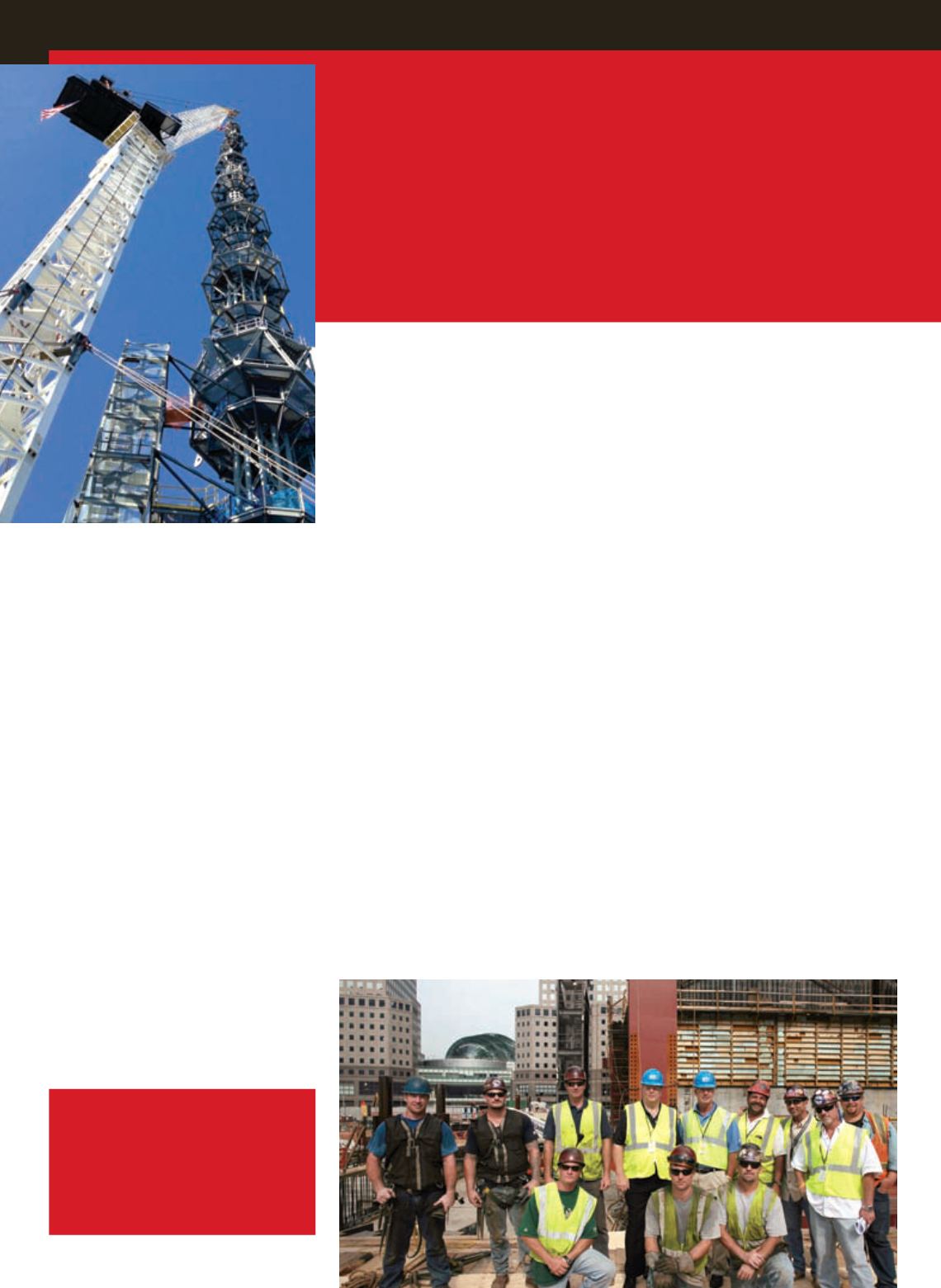
42
SITE REPORT
RIGGING
ACT
JULY 2013
I
t was a crowning moment on a
beautiful morning in May when
the final spire for One World Trade
Center was set in place on top of the
building known as Freedom Tower.
With the spire in place, the building is
now the tallest structure in the western
hemisphere at 1,776 feet, according to the
Port Authority of New York. The spire
itself will serve as a broadcasting antenna.
Placing the spire and its pedestal
required a huge effort that encompassed
a cadre of designers, engineers, crane
operators, riggers and workers, all of
whom were said to be proud and honored
to take part in this sentimental, yet
monumental effort.
Two diesel-powered M760 Favco tower
cranes, which have been on-site since the
jobsite was a hole in the ground, played
a huge role in the successful project, says
James Lomma of J.F. Lomma Inc., and
whose company owned the cranes.
From the time they were erected about
seven years ago and until they set the
final piece of the spire, the cranes had
been performing steel and siding work on
the building.
In March and April, the first truckloads
While it looked seamless, the effort to lift and place the final
spire atop the One World Trade Center building in New York
City was an incredible feat of engineering and expertise.
Crowning
The top section of the 408-foot spire
brought the building to its final height
of 1,776 feet, a symbolic elevation that
memorializes the year in which the
Declaration of Independence was signed.
The rigging crew gathered for a picture,
proud of their history-making roles.
“This was a really tough job, if you
can imagine freestanding a tower crane
180 feet on the top of a 1,600-foot high
building,” says Lomma. “It was a very
challenging project.”
Lomma says wind was an issue the
entire time. Weather and rain caused a
few delays.
The Favco M760 hoisted the spire
foundation and sections to the top of
building. Once the pieces were stored
on top of the building, the second
freestanding Favco M760 began tedious
process of erecting the spire sections,
Lomma says.
Many entities played a role in the spire
erection, including ASC Industries/
Python America and its New York City
distribution center The Bilco Group,
which supplied the high performance
wire rope used on the tower cranes.
Slingmax designed the high performance
Twin-Path slings used to lift the spire
section, according to Tony Fastuca, vice
president, Python America and High
Performance Products.
“The combination of 3,600 feet of 42
mm Python Compac 35 RLL 2160 grade
true non-rotating rope was required and
specified for the Favco M760 to lift the
spire,” Fastuca says. “The rigging dealt
with the SlingMax Twin-path slings
that are comprised of a blend of high
performance fibers with Dyneema. These
There are hundreds of videos on the
Internet of the placing of the spire on One
World Trade Center. Among our favorites
is this one:
story/news/nation/2013/05/10/world-
trade-center-spire/2149449/.
of the spire sections were hauled into
New York City in the wee hours of the
morning. They had been barged from
Canada and then trucked to the site. A
600-ton capacity Terex Demag AC500
owned by New York Crane lifted the
sections off the transporters to a staging
area.
As the final touches were put on the lift
and erection plan, the tower cranes had
to be re-rigged and prepared for their
final job on the project. DCM Erectors
prepared the lift plan for General
Contractor Tishman Construction Corp.
“DCM had to purchase a new winch
drum, which was made in Australia, from
TES, the North American Favco dealer
for the Favco M760 that would lift the
final spire sections,” explains Lomma.
“They had to have a winch that could
handle 3,500 feet of cable. It had to go
from single to two-part.”
Freestanding crane
New York Crane supplied the 14 tower
sections and climbing frames to freestand
the crane 180 feet, the height needed to
erect the spire.


